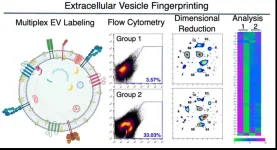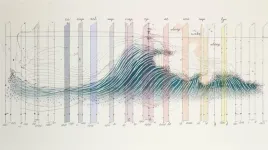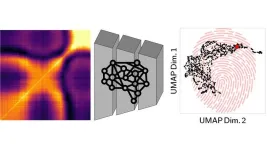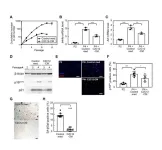(Press-News.org) Bacteria have developed special defense mechanisms to protect themselves against viruses, which by no means infect only humans. As part of these so-called CRISPR-Cas systems, a CRISPR ribonucleic acid (crRNA), which serves as a “guide RNA,” recognizes regions of a foreign genome, such as viral DNA. The CRISPR-associated (Cas) nuclease, directed by a crRNA, then renders it harmless by cutting it like a pair of scissors. Humans have exploited this strategy: “CRISPR, often referred to as ‘gene scissors’, is the basis of many molecular technologies,” says Chase Beisel, head of the RNA Synthetic Biology department at the Helmholtz Institute for RNA-based Infection Research (HIRI) in Würzburg. The institute is a site of the Braunschweig Helmholtz Centre for Infection Research (HZI) in cooperation with the Julius-Maximilians-Universität (JMU) of Würzburg, where Beisel holds a professorship.
The diagnostic platform LEOPARD, developed by Beisel’s lab in cooperation with JMU in 2021, also leverages CRISPR as a technology. LEOPARD has the potential to detect a variety of disease-related biomarkers in just one test. The approach is based on reprogramming RNA factors, so-called tracrRNAs. Those RNAs are naturally involved in helping produce guide RNAs used by Cas9 and different Cas12 nucleases. “LEOPARD focused on Cas9. However, CRISPR-Cas systems also include another diverse set of nucleases, called Cas12,” explains Beisel. While both Cas9 and Cas12 cut DNA targets, Cas12 can increase the output signal by performing cuts on “collateral” DNA. This can make detection technologies more sensitive and, therefore, more efficient.
The team led by Chase Beisel has now extended the unique features of LEOPARD to Cas12. The researchers have named the resulting method PUMA (Programmable tracrRNAs Unlock protospacer-adjacent Motif-independent detection of ribonucleic Acids by Cas12 nucleases). The details of their findings are the subject of a paper in the journal Nature Communications.
Overcoming hurdles
Although Cas12 nucleases are widely used in molecular diagnostics, two major limitations have persisted: Cas12-based technologies have been restricted to DNA targets, and a specific recognition sequence called a PAM, short for protospacer-adjacent motif, is required to identify the target molecule.
PUMA elegantly addresses these challenges. Like LEOPARD, this new method also relies on tracrRNAs. “Using PUMA, we can reprogram the tracrRNAs. This allows us to decide which RNA biomarker becomes a guide RNA. This guide RNA, in turn, directs Cas12 to a DNA molecule that we provide and activates the gene scissors,” explains the study's first author, Chunlei Jiao. Chunlei Jiao, a former graduate student and postdoctoral researcher in the Beisel lab, was also involved in the development of LEOPARD. He recently started a professorship at the National University of Singapore. “DNA cutting then tells us which biomarker was present in the sample, such as biomarkers specific to different pathogens,” adds Beisel.
The novel method therefore enables the detection of RNA biomarkers using CRISPR nucleases that can normally only recognize DNA. “This is particularly important for molecular biomarkers that can only be found at the RNA level. This includes RNA viruses, for example,” says Beisel. And yet, PUMA does not require a specific recognition sequence: The PAM is contained in the DNA target molecule provided. Since the researchers provide the target molecule, they can also introduce truncated DNA. As a result, they were able to significantly increase the speed of the method.
Several birds, one stone
“PUMA has the potential to become a flexible and precise tool for RNA detection,” concludes Beisel. Finally, the team demonstrated the potential of the method by identifying five bacterial pathogens associated with acute sepsis. Their detection relied on a single universal, reprogrammed tracrRNA, which provides a simplified means of differentiating between various types of bacteria. This opens up a wide range of potential applications in medicine: “The new technology represents a novel form of CRISPR diagnostics that enables reliable molecular testing at the point of care—whether for the identification of viral or bacterial pathogens or the detection of cancer biomarkers,” says Jiao.
The research team is already planning its next steps: “Our goal is to achieve a multiplexed readout similar to that of LEOPARD and to expand the range of applications for the technology,” says Beisel, who also anticipates broad use in the research community: “We hope that our study will spur further exploration of tracrRNA reprogramming.”
Funding
The study was supported by funds from the European Research Council (ERC Consolidator Award to Chase Beisel) and the “GO-Bio initial” program of the German Federal Ministry of Education and Research (BMBF).
Helmholtz Centre for Infection Research:
Scientists at the Helmholtz Centre for Infection Research (HZI) in Braunschweig and its other sites in Germany are engaged in the study of bacterial and viral infections and the body’s defence mechanisms. They have a profound expertise in natural compound research and its exploitation as a valuable source for novel anti-infectives. As member of the Helmholtz Association and the German Center for Infection Research (DZIF) the HZI performs translational research laying the ground for the development of new treatments and vaccines against infectious diseases. www.helmholtz-hzi.de/en
Helmholtz Institute for RNA-based Infection Research:
The Helmholtz Institute for RNA-based Infection Research (HIRI) is the first institution of its kind worldwide to combine ribonucleic acid (RNA) research with infection biology. Based on novel findings from its strong basic research program, the institute’s long-term goal is to develop innovative therapeutic approaches to better diagnose and treat human infections. HIRI is a site of the Braunschweig Helmholtz Centre for Infection Research (HZI) in cooperation with the Julius-Maximilians-Universität Würzburg (JMU) and is located on the Würzburg Medical Campus. More information at www.helmholtz-hiri.de.
END
A new addition to the CRISPR toolbox: Teaching the gene scissors to detect RNA
HIRI researchers present the PUMA technology for the precise detection of RNA with DNA-cutting Cas12 nucleases
2024-07-16
ELSE PRESS RELEASES FROM THIS DATE:
Vanderbilt scientists develop new tool that could lead to noninvasive “liquid biopsies”
2024-07-16
Biopsies are clinical tools commonly used to diagnose a variety of diseases or to monitor tissue for abnormal growth or even rejection of a transplant. During biopsies, tissue samples are removed from the body so they can be examined more closely, but depending on the type of tissue that’s needed, the procedure can be rather invasive.
Researchers from the School of Medicine Basic Sciences recently developed an analytical tool that could lead to the use of “liquid biopsies” as a substitute ...
Many breast cancer survivors do not receive genetic testing, despite being eligible
2024-07-16
ANN ARBOR, Michigan — As cancer treatment and survivorship care relies more on understanding the genetic make-up of an individual’s tumor, a new study from the University of Michigan Health Rogel Cancer Center finds that many breast cancer survivors who meet criteria for genetic counseling and testing are not receiving it.
The good news: Among those who do get testing, nearly two-thirds who have a genetic variant are reaching out to family members to talk about their results.
“Our findings support a rapidly growing movement to simplify clinical guidelines to ...
Scientists find that small regions of the brain can take micro-naps while the rest of the brain is awake and vice versa
2024-07-16
Sleep and wake: they’re totally distinct states of being that define the boundaries of our daily lives. For years, scientists have measured the difference between these instinctual brain processes by observing brain waves, with sleep characteristically defined by slow, long-lasting waves measured in tenths of seconds that travel across the whole organ.
For the first time, scientists have found that sleep can be detected by patterns of neuronal activity just milliseconds long, 1000 times shorter than a second, revealing a new way to study and understand the basic brain ...
Scientists develop new artificial intelligence method to create material ‘fingerprints’
2024-07-16
Study shows how materials change as they are stressed and relaxed.
Like people, materials evolve over time. They also behave differently when they are stressed and relaxed. Scientists looking to measure the dynamics of how materials change have developed a new technique that leverages X-ray photon correlation spectroscopy (XPCS), artificial intelligence (AI) and machine learning.
This technique creates “fingerprints” of different materials that can be read and analyzed by ...
Sun-like stars found orbiting hidden companions
2024-07-16
Most stars in our universe come in pairs. While our own Sun is a loner, many stars like our Sun orbit similar stars, while a host of other exotic pairings between stars and cosmic orbs pepper the universe. Black holes, for example, are often found orbiting each other. One pairing that has proved to be quite rare is that between a Sun-like star and a type of dead star called a neutron star.
Now, astronomers led by Caltech's Kareem El-Badry have uncovered what appear to be 21 neutron stars in orbit around stars like our Sun. Neutron stars are dense burned-out ...
Roles of PEDF in exercise-induced suppression of senescence and its impact on lung pathology in mice
2024-07-16
“[...] the present results strongly suggest the potential of PEDF as a myokine linking exercise training to the suppression of senescence.”
BUFFALO, NY- July 16, 2024 – A new research paper was published on the cover of Aging (listed by MEDLINE/PubMed as "Aging (Albany NY)" and "Aging-US" by Web of Science) Volume 16, Issue 13, entitled, “Roles of pigment epithelium-derived factor in exercise-induced suppression of senescence and its impact on lung pathology in mice.”
Senescent cells contribute ...
HER2-low and HER2-zero in breast cancer between prognosis, prediction and entity
2024-07-16
“[...] we found an independent positive prognostic effect of HER2-low compared to HER2-zero in early breast cancer.”
BUFFALO, NY- July 16, 2024 – A new editorial paper was published in Oncotarget's Volume 15 on June 20, 2024, entitled, “HER2-low and HER2-zero in breast cancer between prognosis, prediction and entity.”
In this new editorial, researchers Marcus Schmidt, Hans-Anton Lehr, and Katrin Almstedt from the University Medical Center of Johannes Gutenberg University discuss HER2 in breast cancer. HER2 is a well-established prognostic and predictive factor in breast ...
How to assess a general-purpose AI model’s reliability before it’s deployed
2024-07-16
CAMBRIDGE, MA — Foundation models are massive deep-learning models that have been pretrained on an enormous amount of general-purpose, unlabeled data. They can be applied to a variety of tasks, like generating images or answering customer questions.
But these models, which serve as the backbone for powerful artificial intelligence tools like ChatGPT and DALL-E, can offer up incorrect or misleading information. In a safety-critical situation, such as a pedestrian approaching a self-driving car, these mistakes could have serious consequences.
To help prevent such mistakes, researchers from MIT and the MIT-IBM Watson AI Lab developed a technique to estimate the reliability ...
Advancing quantum research – DOE inks MOU with Department of Defense
2024-07-16
WASHINGTON, D.C. - Today, the U.S. Department of Energy (DOE) and the Defense Advanced Research Projects Agency (DARPA) announce a Memorandum of Understanding (MOU) to coordinate efforts to move the needle on quantum computing.
“Realizing practical quantum computers has the potential to dramatically accelerate the pace of discovery across the science and technology landscape,” said Ceren Susut, DOE Associate Director of Science for the Advanced Scientific Computing Research program. “The Office of Science is proud to bring decades of experience in fundamental science for quantum ...
Transporting precious cargo using the body’s own delivery system
2024-07-16
Each cell in the body has its own unique delivery system that scientists are working on harnessing to move revolutionary biological drugs — molecules like proteins, RNA and combinations of the two — to specific diseased parts of the body.
A new study from Northwestern University hijacked the transit system and sent tiny, virus-sized containers to effectively deliver an engineered protein to its target cell and trigger a change in the cell’s gene expression. The success came from encouraging engineered proteins to move toward a specific cell membrane structure that the researchers found increased a protein’s likelihood of latching onto the container.
Published ...
LAST 30 PRESS RELEASES:
Scientists trace microplastics in fertilizer from fields to the beach
The Lancet Obstetrics, Gynecology, & Women’s Health: Taking paracetamol during pregnancy does not increase risk of autism, ADHD or intellectual disabilities, confirms new gold-standard evidence review
Taking paracetamol during pregnancy does not increase risk of autism, ADHD or intellectual disabilities
Harm reduction vending machines in New York State expand access to overdose treatment and drug test strips, UB studies confirm
University of Phoenix releases white paper on Credit for Prior Learning as a catalyst for internal mobility and retention
Canada losing track of salmon health as climate and industrial threats mount
Molecular sieve-confined Pt-FeOx catalysts achieve highly efficient reversible hydrogen cycle of methylcyclohexane-toluene
Investment in farm productivity tools key to reducing greenhouse gas
New review highlights electrochemical pathways to recover uranium from wastewater and seawater
Hidden pollutants in shale gas development raise environmental concerns, new review finds
Discarded cigarette butts transformed into high performance energy storage materials
Researchers highlight role of alternative RNA splicing in schizophrenia
NTU Singapore scientists find new way to disarm antibiotic-resistant bacteria and restore healing in chronic wounds
Research suggests nationwide racial bias in media reporting on gun violence
Revealing the cell’s nanocourier at work
Health impacts of nursing home staffing
Public views about opioid overdose and people with opioid use disorder
Age-related changes in sperm DNA may play a role in autism risk
Ambitious model fails to explain near-death experiences, experts say
Multifaceted effects of inward foreign direct investment on new venture creation
Exploring mutations that spontaneously switch on a key brain cell receptor
Two-step genome editing enables the creation of full-length humanized mouse models
Pusan National University researchers develop light-activated tissue adhesive patch for rapid, watertight neurosurgical sealing
Study finds so-called super agers tend to have at least two key genetic advantages
Brain stimulation device cleared for ADHD in the US is overall safe but ineffective
Scientists discover natural ‘brake’ that could stop harmful inflammation
Tougher solid electrolyte advances long-sought lithium metal batteries
Experts provide policy roadmap to reduce dementia risk
New 3D imaging system could address limitations of MRI, CT and ultrasound
First-in-human drug trial lowers high blood fats
[Press-News.org] A new addition to the CRISPR toolbox: Teaching the gene scissors to detect RNAHIRI researchers present the PUMA technology for the precise detection of RNA with DNA-cutting Cas12 nucleases





